site
map
france
new! Cathedrale Saint-Gatien at Tours 
 updated: Romanesque churches and cathedrals in south-west France updated: Romanesque churches and cathedrals in south-west France
the perpendicular or English style of cathedral 
the fire at the cathedral of Notre-Dame de Paris

cathedral giants - Amiens and Beauvais
Stone tracery in church and
cathedral construction 
stone in church and cathedral construction stained glass and cathedrals in Normandy  
fortified churches, mostly in Les Landes
cathedral labyrinths and mazes in France
using metal in gothic cathedral construction
Germans in France
cathedral destruction during the French revolution, subsidiary page to Germans in France

on first arriving in France - driving
France is not England
paying at the péage (toll station)

Transbordeur bridges in France and the world 2: focus on Portugalete, Chicago,
Rochefort-Martrou
Gustave Eiffel’s first work: the Eiffel passerelle, Bordeaux
a fifth bridge coming to Bordeaux: pont Chaban-Delmas, a new vertical lift bridge
France’s western isles: Ile de Ré
France’s western iles: Ile d’Oleron
Ile de France, Paris: in the context of Abelard and of French cathedrals
short biography of Pierre (Peter) Abelard
Marianne - a French national symbol, with French definitive stamps
la Belle Epoque
Grand Palais, Paris


Pic du Midi - observing stars clearly, A64
Carcassonne, A61: world heritage fortified city
Futuroscope
Vulcania
Space City, Toulouse
the French umbrella & Aurillac
50 years old:
Citroën DS
the Citroën 2CV:
a French motoring icon
the forest as seen by Francois Mauriac, and today
Les Landes, places and playtime
roundabout art of Les Landes
Hermès scarves

bastide towns
mardi gras! carnival in Basque country
country life in France: the poultry fair
what a hair cut! m & french pop/rock

Le Tour de France: cycling tactics 
|
the
department of hautes pyrénées
The
Département of Hautes-Pyrénées is a
relatively small department, both in surface area (4,388 km²/1,694
mi²) and population (121,419). This department has has several
geographical areas. To the south are the central Pyrénées
mountains, which border Spain. The Pyrenees range has over twenty
peaks higher than 3,000 metres, few rising above 10,000 feet. The
Observatory at the Pic du Midi offers astounding panoramic
views across the Pyrenees range. Older than the Alps, the sediments
in the Pyrenees were first deposited during the Paleozoic and
Mesozoic eras. This mountain area is a regular and popular part
of the annual
Tour de France, providing gruelling cycling with amazing scenery.
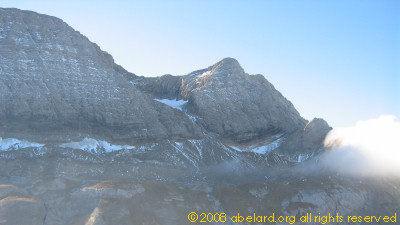
Near the Brèche de Roland, Gavarnie
- the remaining glaciers
click
on photo for larger version
Going north into France
are high pastures, then rolling foot hills with verdant chestnut
and oak forests. Here, sheep, cattle, goats and horses roam freely.
The landscape changes again to the north of the Department, with
flat, agricultural plains stretching to its border with Gers.
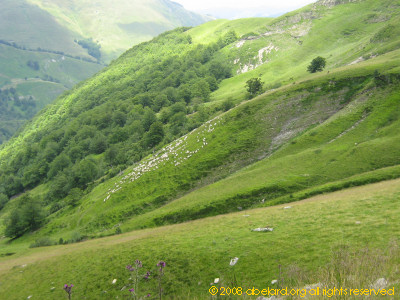
High pastures, with a large flock of sheep
click on photo for larger version
Tourism is a major revenue source for this department,
winter sports and summer hiking being important activities. There
are many ski resorts [stations de ski] for all abilities,
while the Pyrenees
National Park, extending over 45,000 hectares, is a natural
wonderland of  alpine
flowers, animals and birds. The National Park is protected from
construction and touristic over-use, with a peripheral area extending
into the foothills. With well-marked footpaths and overnight shelters
(rather like youth hostels), there are many opportunities for
hiking and observing nature. To make sure of seeing wild animals,
you can visit the animal
park at Argéles-Gazost, where there is also a Natural
History Museum. alpine
flowers, animals and birds. The National Park is protected from
construction and touristic over-use, with a peripheral area extending
into the foothills. With well-marked footpaths and overnight shelters
(rather like youth hostels), there are many opportunities for
hiking and observing nature. To make sure of seeing wild animals,
you can visit the animal
park at Argéles-Gazost, where there is also a Natural
History Museum.
 Some
of the large birds that you may well see soaring in the mountains
are vultures or golden eagles. Brown bears have been re-introduced,
and wolves also live in secluded mountainous areas. The lower
woods are also home to wild boar, deer and red squirrels, that
often look close to black. Some
of the large birds that you may well see soaring in the mountains
are vultures or golden eagles. Brown bears have been re-introduced,
and wolves also live in secluded mountainous areas. The lower
woods are also home to wild boar, deer and red squirrels, that
often look close to black.
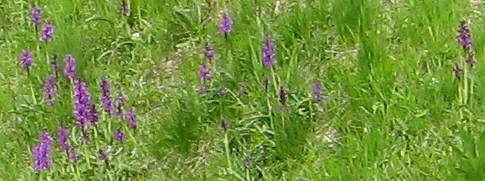
Orchids in Hautes-Pyrenees
Pau
Pau, capital of the département of Hautes-Pyrénées,
is birthplace of Henry
IV of France [1553 - 1610]. His mother was Jeanne
d’Albret, Queen of Navarre, whose family titles
included Navarre
and Béarn as well as the countdom of Foix,
and whose vast territories included much of Les
Landes and extended around Agen,
to Périgord and to the viscomtdom of Limoges. Jeanne
converted to Huguenot Protestantism in 1560, seven years
after the birth of Henry. Henry of Navarre became the
first Protestant to become king of France, after converting
to Catholicism, supposedly with the comment, “Paris
vaut bien une messe” - “Paris is well
worth a mass”.
English travellers
came to Pau from the late 18th century, to enjoy its climate and
healthy air, encouraged by Wellington, who had left a garrison
at Pau on his way into Spain during the Peninsular War against
Napoleon I. Holidaying British, who came even before the railroad
was built, made their mark with the scenic Boulevard des Pyrénées,
the first full 18-hole golf course in Europe (laid out in between
1856 to 1860, and still existing), and a real
tennis court.
Napoleon
III refurbished the château, and there are streets of Belle Époque architecture, built before Biarritz become the fashionable resort. Pau is a major winter sports centre,
and equestrian events such as a famous steeplechase are held there.
Pau’s
prosperity is now based on helicopter manufacturer Turbomeca,
as well as tourism and agriculture. The French fossil fuel company,
Elf Aquitaine, is based at Pau.
Lourdes
The
most prominent feature used to be the fortified castle which rises
up from the centre of the town on a rocky escarpment. However,
with the burgeoning Christian fervour and attraction of this town,
there are now many religious edifices to compete for attention.

View across Bartres, a typical Pyrenean village,
where
Bernardette stayed at times during her childhood,
to
the Pyrenees mountain range.
click
on photo for larger version
Lourdes has the second
greatest number of hotels in France after Paris with about 270
establishments. After alleged apparitions of “Our Lady of
Lourdes” to Bernadette Soubirous in 1858, Lourdes has developed
into a major place of Christian pilgrimage. 2008 was
the 150th anniversary of her ‘visions’.
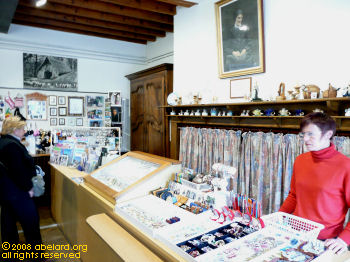
Gift shop at Bartres, in a house where Bernadette
stayed at times during her childhood
click
on photo for larger version
|

|
the
Pic du Jer funicular railway
Entering Lourdes on
the D821, the road from Cauterets, then
the N21, you can see on the right the straight line of the impressive funicular
railway that rises 480 metres, over 1,000 feet to the summit
with its panoramic view over the town of Lourdes.

Operating
since 1900, the funicular has a single line with a passing place
about half way up (left). On the right, one car has almost reached
the top, while the other emerges from the tunnel before approaching
the lower station.
At the summit are grottos, an observatory
and a restaurant.
[Note: the top station is at 880 metres,
with the restaurant is nearby. There is an uphill, mostly gentle,
walk on a hairpin path, the ‘bend’ being at 911 metres.
The grottos are at 932 and 933 metres, there are ruins at 928
metres, the viewing point is at 934 metres, while the summit cross
is at 948 metres. There are also subterranean paths.]
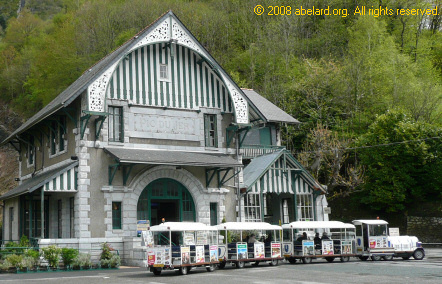
Lourdes
funicular railway station, with the Petit train touristique
related:
le
petit train of the Rhune funicular railway.
Gavarnie
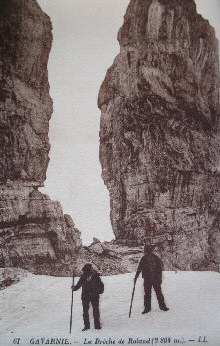 Gavarnie
is a base for walking in high mountains, admiring the spectacular
scenery, the jewel- like flowers, the soaring eagles. You might
even see a marmoset guarding its burrow. The Cirque de Gavarnie
is a two-hour walk from the village, or you can ride up on a mule.
For more experienced walkers, the High Pyrenean Walking Route
follows the heights, with refuges for overnight stops. Gavarnie
is a base for walking in high mountains, admiring the spectacular
scenery, the jewel- like flowers, the soaring eagles. You might
even see a marmoset guarding its burrow. The Cirque de Gavarnie
is a two-hour walk from the village, or you can ride up on a mule.
For more experienced walkers, the High Pyrenean Walking Route
follows the heights, with refuges for overnight stops.
Cirque
de Gavarnie is a famous example of a cirque in the central Pyrenees,
in the Pyrenees National Park. The cirque is 800m wide (on the
deepest point) and about 3000m wide at the top. It incorporates
seventeen peaks that are over 3,000 metres, with the highest waterfall
in Europe at 423 metres - the Gavarnie Falls.
A major feature
of the cirque is La Brèche de Roland (Roland’s Breach,
also called the Roncevaux Pass), supposedly created by Roland,
a nephew of Charlemagne. According to legend, Roland owned a sword
reputed to be indestructible, that had previously belonged to
Hector of Troy. To prevent the sword falling into the hands of
the Sarasens, Roland attempted to destroy it by hacking at the
rocks. He managed to cut a gap 40 metres wide and 100 metres high.

On the road between Gavarnie and the high
mountains
click
on photo for larger version
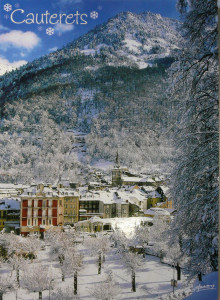
Cauterets
Like
Gavarnie, Cauterets is walking territory during the warmer months,
but during the colder parts of the year, Cauterets is a major
skiing resort, for both cross-country and downhill skiing, with
cable-cars up to the pistes running all through the day, and visible
from town centre hotels.
As well as being a ski resort,
like many mountain towns, Cauterets is also a spa town. Thermal
springs welling up from the ground provide mineral-rich waters,
containing calcium sulphates, iron, sulphur and sodium. These
are used to treat respiratory and skin diseases, as well as rheumatism
and other complaints.
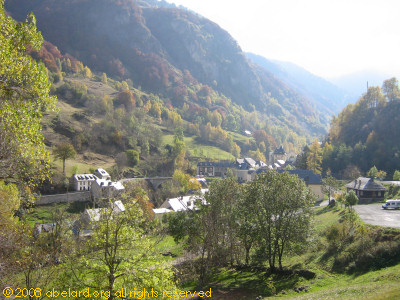
Looking down the Cauterets valley
click
on photo for larger version
A local speciality are the flavoured boiled sweets, berlingots
[the name refers to the shape of the sweet]. These are
made in several sweet shops in the town, and you can watch
the stages in making striped boiled sweets - a quite extraordinary
process. As well as being able to buy bags and boxes of
mixtures that you’ve chosen, from at least one shop
it is possible to order and have sweets sent to your home.

Berlingot boiled sweets being made
in a Cauterets boutique
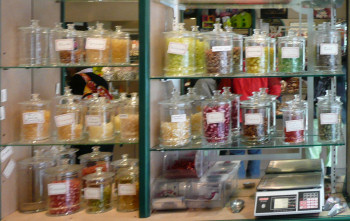
Jars of different flavoured berlingots,
Cauterets
 In
1873, a weather station was set up on the Col de Sencours, below the Pic de Midi.
The foundation stone for the Observatory was laid five
years later. This Observatory, now listed natural site,
has been opened to the public since 2000. Thus, it is
visitable, providing you do not mind riding in “a
bucket on a string” [a cable car]. The trip starts
at 1 800 metres. Fifteen minutes later, you reach the
Observatory at an altitude of 2,877 metres for a two-hour
visit. In
1873, a weather station was set up on the Col de Sencours, below the Pic de Midi.
The foundation stone for the Observatory was laid five
years later. This Observatory, now listed natural site,
has been opened to the public since 2000. Thus, it is
visitable, providing you do not mind riding in “a
bucket on a string” [a cable car]. The trip starts
at 1 800 metres. Fifteen minutes later, you reach the
Observatory at an altitude of 2,877 metres for a two-hour
visit.
Here are the most spectacular views across the snow-topped
Pyrenees to the plains southern France and north to the
Massif Central foothills. There is a museum and discovery
area where you can understand the astronomical research
being done with the three telescopes, including a solar
telescope. There is also a restaurant, a snack bar and
a gift shop. Visitors should take both warm clothing and
sun glasses, and take account of being almost 1.8 miles
higher than sea level.
See also Pic
du Midi - observing space clearly for much more detail
and many illustrations.
the
A64 autoroute/motorway
The
A64 motorway, La Pyrénéenne, runs through
the northern plains of the department of Hautes Pyrenees,
on its route parallel to the Pyrenees mountain range.
Amongst its many aires de repose and aires
de service are two that provide more than just a
peaceful stop for picnicking and ‘escaping’
the confines of a car.
end
notes
- Département
- the above is the French way of spelling the word that Anglo-Saxons
spell as department. Here at abelard.org,
we use both spellings when describing the French administrative
department, which is fairly equivalent to an American state or British
county.
- For a map of the modern départements
of France, see the map at the abelard.org France Zone.
- The French and the
English spell compound words and phrases, such as Pyrenees Atlantiques
and Pays Basque differently from us Anglo-Saxons. Also note that the
French also often pronounce words somewhat differently: dropping final
consonants in many instances, being more meticulous to pronounce each
vowel with a clearly different sound, and usually pronouncing every
syllable.
At abelard.org, we tend to ring the changes between
French and English spellings, and even sometimes use a mixture, as in
Basqueland!
But why is the French version of Pyrenees Atlantiques spelt Pyrénées-atlantiques,
and why does Pays Basque not have an ‘s’ at the end of the
second word?
Pyrénées-atlantiques: In French, with
a double-barrelled word, the second word matches the first word on whether
it is singular or plural. In French, the Pyrenees is a plural word -
the collective noun for that range of mountains, so the accompanying
adjective (describing word: Atlantique) also ends in ‘s’.
In French, the second word in a hyphenated compound noun is written
in lower case. This is why ‘atlantiques’ is in lower case.
Pays Basque: In French, the word for country, le
pays, is singular. Thus the accompanying adjective, Basque, is
also given as the singular, that is without an ‘s’ at the
end.
|





















